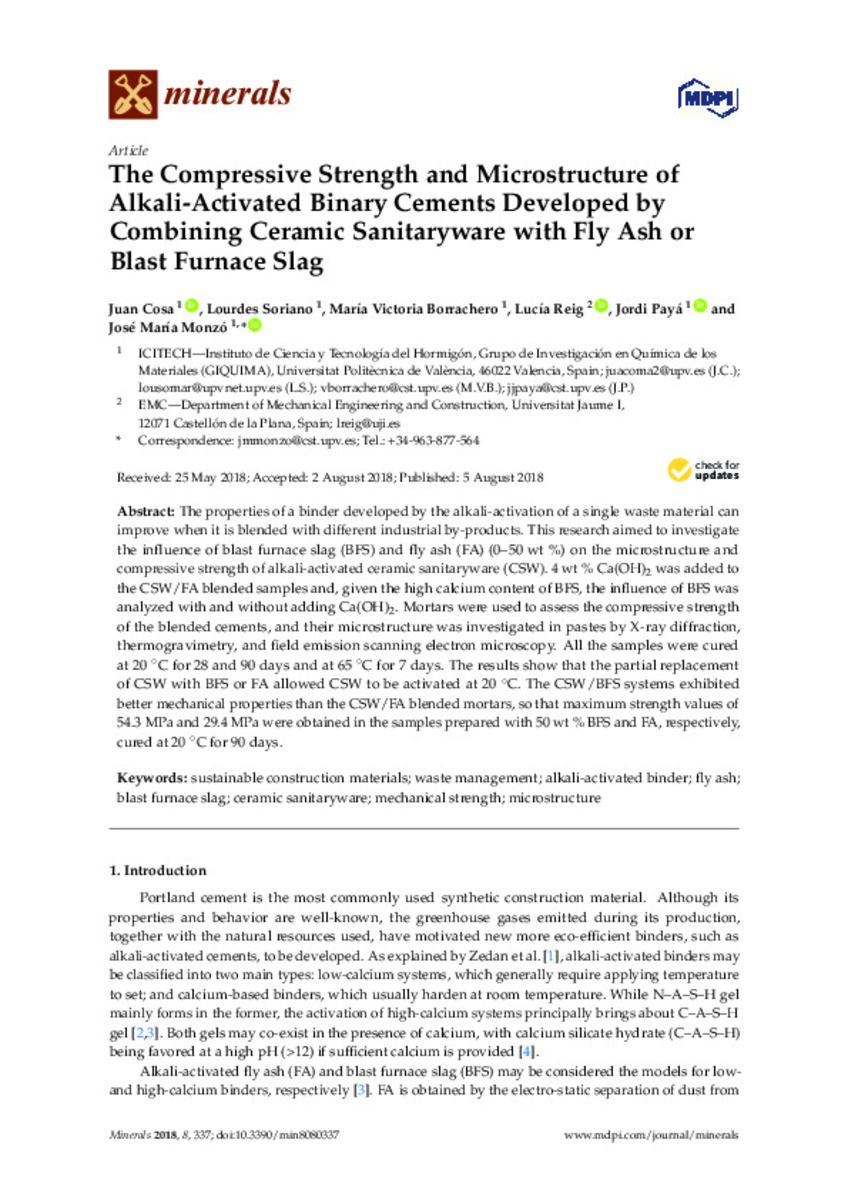Mostrar el registro sencillo del ítem
The Compressive Strength and Microstructure of Alkali-Activated Binary Cements Developed by Combining Ceramic Sanitaryware with Fly Ash or Blast Furnace Slag
| dc.contributor.author | Cosa, Juan | |
| dc.contributor.author | Soriano, Lourdes | |
| dc.contributor.author | Borrachero, Mª Victoria | |
| dc.contributor.author | Reig, Lucía | |
| dc.contributor.author | PAYÁ, JORDI | |
| dc.contributor.author | Monzó, José María | |
| dc.date.accessioned | 2018-10-11T07:54:24Z | |
| dc.date.available | 2018-10-11T07:54:24Z | |
| dc.date.issued | 2018 | |
| dc.identifier.citation | COSA, Juan, et al. The Compressive Strength and Microstructure of Alkali-Activated Binary Cements Developed by Combining Ceramic Sanitaryware with Fly Ash or Blast Furnace Slag. Minerals, 2018, vol. 8, no 8, p. 337. | ca_CA |
| dc.identifier.issn | 2075-163X | |
| dc.identifier.uri | http://hdl.handle.net/10234/176674 | |
| dc.description.abstract | The properties of a binder developed by the alkali-activation of a single waste material can improve when it is blended with different industrial by-products. This research aimed to investigate the influence of blast furnace slag (BFS) and fly ash (FA) (0–50 wt %) on the microstructure and compressive strength of alkali-activated ceramic sanitaryware (CSW). 4 wt % Ca(OH)2 was added to the CSW/FA blended samples and, given the high calcium content of BFS, the influence of BFS was analyzed with and without adding Ca(OH)2. Mortars were used to assess the compressive strength of the blended cements, and their microstructure was investigated in pastes by X-ray diffraction, thermogravimetry, and field emission scanning electron microscopy. All the samples were cured at 20 ◦C for 28 and 90 days and at 65 ◦C for 7 days. The results show that the partial replacement of CSW with BFS or FA allowed CSW to be activated at 20 ◦C. The CSW/BFS systems exhibited better mechanical properties than the CSW/FA blended mortars, so that maximum strength values of 54.3 MPa and 29.4 MPa were obtained in the samples prepared with 50 wt % BFS and FA, respectively, cured at 20 ◦C for 90 days. | ca_CA |
| dc.format.extent | 19 p. | ca_CA |
| dc.format.mimetype | application/pdf | ca_CA |
| dc.language.iso | eng | ca_CA |
| dc.publisher | MDPI | ca_CA |
| dc.relation.isPartOf | Minerals 2018, 8 | ca_CA |
| dc.rights | © 2018 by the authors. Licensee MDPI, Basel, Switzerland. This article is an open access article distributed under the terms and conditions of the Creative Commons Attribution (CC BY) license (http://creativecommons.org/licenses/by/4.0/). | ca_CA |
| dc.rights | Atribución 4.0 Internacional | * |
| dc.rights.uri | http://creativecommons.org/licenses/by-sa/4.0/ | * |
| dc.subject | sustainable construction materials | ca_CA |
| dc.subject | waste management | ca_CA |
| dc.subject | alkali-activated binder | ca_CA |
| dc.subject | fly ash | ca_CA |
| dc.subject | blast furnace slag | ca_CA |
| dc.subject | ceramic sanitaryware | ca_CA |
| dc.subject | mechanical strength | ca_CA |
| dc.subject | microstructure | ca_CA |
| dc.title | The Compressive Strength and Microstructure of Alkali-Activated Binary Cements Developed by Combining Ceramic Sanitaryware with Fly Ash or Blast Furnace Slag | ca_CA |
| dc.type | info:eu-repo/semantics/article | ca_CA |
| dc.identifier.doi | https://doi.org/10.3390/min8080337 | |
| dc.relation.projectID | APLIGEO BIA2015-70107-R | ca_CA |
| dc.rights.accessRights | info:eu-repo/semantics/openAccess | ca_CA |
| dc.relation.publisherVersion | https://www.mdpi.com/2075-163X/8/8/337 | ca_CA |
| dc.type.version | info:eu-repo/semantics/publishedVersion | ca_CA |
Ficheros en el ítem
Este ítem aparece en la(s) siguiente(s) colección(ones)
-
EMC_Articles [811]
Excepto si se señala otra cosa, la licencia del ítem se describe como: © 2018 by the authors. Licensee MDPI, Basel, Switzerland. This article is an open access
article distributed under the terms and conditions of the Creative Commons Attribution
(CC BY) license (http://creativecommons.org/licenses/by/4.0/).








